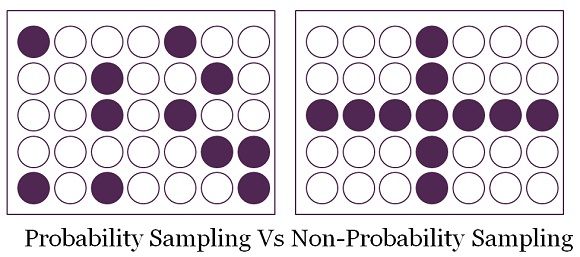 Sampling means selecting a particular group or sample to represent the entire population. Sampling methods are majorly divided into two categories probability sampling and non-probability sampling. In the first case, each member has a fixed, known opportunity to belong to the sample, whereas in the second case, there is no specific probability of an individual to be a part of the sample. For a layman, these two concepts are same, but in reality, they are different in the sense that in probability sampling every member of the population gets a fair chance of selection which is not in the case with non-probability sampling. Other important differences between probability and non-probability sampling are compiled in the article below.
Sampling means selecting a particular group or sample to represent the entire population. Sampling methods are majorly divided into two categories probability sampling and non-probability sampling. In the first case, each member has a fixed, known opportunity to belong to the sample, whereas in the second case, there is no specific probability of an individual to be a part of the sample. For a layman, these two concepts are same, but in reality, they are different in the sense that in probability sampling every member of the population gets a fair chance of selection which is not in the case with non-probability sampling. Other important differences between probability and non-probability sampling are compiled in the article below.
Content: Probability Vs Non-Probability
Comparison Chart
| Basis for Comparison | Probability Sampling | Non-Probability Sampling |
|---|---|---|
| Meaning | Probability sampling is a sampling technique, in which the subjects of the population get an equal opportunity to be selected as a representative sample. | Nonprobability sampling is a method of sampling wherein, it is not known that which individual from the population will be selected as a sample. |
| Alternately known as | Random sampling | Non-random sampling |
| Basis of selection | Randomly | Arbitrarily |
| Opportunity of selection | Fixed and known | Not specified and unknown |
| Research | Conclusive | Exploratory |
| Result | Unbiased | Biased |
| Method | Objective | Subjective |
| Inferences | Statistical | Analytical |
| Hypothesis | Tested | Generated |
Definition of Probability Sampling
In statistics, probability sampling refers to the sampling method in which all the members of the population has a pre-specified and an equal chance to be a part of the sample. This technique is based on the randomization principle, wherein the procedure is so designed, which guarantees that each and every individual of the population has an equal selection opportunity. This helps to reduce the possibility of bias.
Statistical inferences can be made by the researchers using this technique, i.e. the result obtained can be generalized from the surveyed sample to the target population. The methods of probability sampling, are provided below:
- Simple Random Sampling
- Stratified Sampling
- Cluster Sampling
- Systematic Sampling
Definition of Non-Probability Sampling
When in a sampling method, all the individuals of the universe are not given an equal opportunity of becoming a part of the sample, the method is said to be Non-probability sampling. Under this technique as such, there is no probability attached to the unit of the population and the selection relies on the subjective judgment of the researcher. Therefore, the conclusions drawn by the sampler cannot be inferred from the sample to the whole population. The methods of non-probability sampling are listed below:
- Convenience Sampling
- Quota Sampling
- Judgment or Purposive Sampling
- Snowball Sampling
Key Differences Between Probability and Non-Probability Sampling
The significant differences between probability and non-probability sampling
- The sampling technique, in which the subjects of the population get an equal opportunity to be selected as a representative sample, is known as probability sampling. A sampling method in which it is not known that which individual from the population will be chosen as a sample, is called nonprobability sampling.
- The basis of probability sampling is randomization or chance, so it is also known as Random sampling. On the contrary, in non-probability sampling randomization technique is not applied for selecting a sample. Hence it is considered as Non-random sampling.
- In probability sampling, the sampler chooses the representative to be part of the sample randomly, whereas, in non-probability sampling, the subject is chosen arbitrarily, to belong to the sample by the researcher.
- The chances of selection in probability sampling, are fixed and known. As opposed to non-probability sampling, the selection probability is zero, i.e. it is neither specified not known.
- Probability sampling is used when the research is conclusive in nature. On the other hand, when the research is exploratory, nonprobability sampling should be used.
- The results generated by probability sampling, are free from bias while the results of non-probability sampling are more or less biased.
- As the subjects are selected randomly by the researcher in probability sampling, so the extent to which it represents the whole population is higher as compared to the nonprobability sampling. That is why extrapolation of results to the entire population is possible in the probability sampling but not in non-probability sampling.
- Probability sampling test hypothesis but nonprobability sampling generates it.
Conclusion
While probability sampling is based on the principle of randomization where every entity gets a fair chance to be a part of the sample, non-probability sampling relies on the assumption that the characteristics are evenly distributed within the population, which make the sampler believe that any sample so selected would represent the whole population and the results drawn would be accurate.
The post Difference Between Probability and Non-Probability Sampling appeared first on Key Differences.